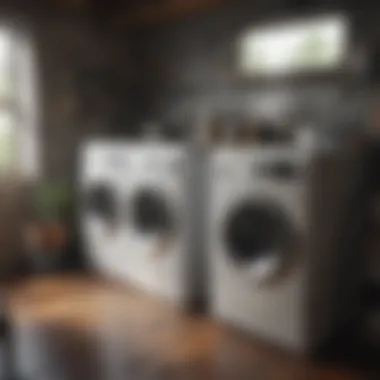Practical Guide to Laundering Clothes in a Sink


Intro
In today's world, the convenience of washing clothes goes beyond traditional methods. For some, access to a washing machine is limited or non-existent. Laundering in a sink provides a practical alternative, ensuring that clothes remain fresh and clean even in the tightest of spaces. This guide aims to provide readers with a thorough understanding of the steps necessary for effective sink laundering, including what materials to gather, the method to use, and considerations for different fabric types.
Knowing how to wash clothes in a sink can save time and resources. It can also be an eco-friendly choice, particularly when using water judiciously and choosing biodegradable detergents. From delicate fabrics to durable materials, this guide covers the essentials. Let’s delve into the materials needed for this home laundering method.
Prolusion to Sink Laundry
Laundering in the sink provides a practical solution for many households. As life varies in pace and priorities, the ability to wash clothes without a machine is beneficial. This method becomes crucial in tight spaces like apartments, while traveling, or during emergencies. The simplicity and immediacy of sink laundry can alleviate the need to wait for laundry day, offering flexibility when schedules are packed.
Relevance of Sink Washing
The relevance of sink washing lies in its accessibility. Not all homes are equipped with washing machines or access to laundry facilities. Many individuals may find themselves in situations where having clean clothes is necessary but might lack the time or resources to go to a laundromat. Moreover, using a sink can save water and energy compared to larger machines. It also serves as a useful skill to develop for those interested in sustainability.
"By utilizing the sink for laundry, you maximize resource efficiency while maintaining your wardrobe’s cleanliness."
Situations for Sink Laundering
There are several situations where sink laundering proves to be especially useful:
- Traveling: When on the go, hotel laundries may not be available or affordable. Washing a few items in the sink can be efficient.
- Quick Refresh: If you have an urgent need for a specific garment, sink wash can provide a swift solution.
- Delicate Fabrics: Some fabrics require gentle care and can benefit from the controlled environment a sink offers.
- Limited Space: In small living arrangements, using the sink eliminates the need for bulky laundry appliances.
- Water Conservation: In regions facing drought or where water is scarce, sink laundering uses less water, appealing to eco-conscious individuals.
Understanding the relevance and ideal situations for sink laundering ensures that readers are equipped to incorporate this technique into their routines efficiently.
Necessary Equipment
Understanding the necessary equipment for sink laundering is fundamental to ensuring effective cleaning. The selection of appropriate tools and supplies directly impacts the outcome of the cleaning process. With limited space and resources, every item must serve a purpose and enhance the efficiency of laundry efforts. This section details the equipment needed, focusing on how each element can streamline the washing experience while prioritizing garment care.
Selecting the Right Sink
The choice of sink can significantly influence the overall success of your laundering efforts. A deeper, larger sink provides more space for submerging clothing, facilitating a thorough wash. Ensure that the sink is clean and devoid of any residue or food particles before beginning. A stainless steel or ceramic sink is preferable due to their durability and ease of cleaning. Opting for a sink with a removable drain plug can also facilitate better control over water levels, further aiding in the washing process. Avoid using sinks in shared spaces without check, as it may lead to potential contamination of your fabrics.
Essential Supplies
The right supplies can make a difference in the sink laundering process. Below are the key components that should be included in your preparation.
Detergent Options
When selecting detergent, consider formulations specifically designed for hand washing. These detergents often have lower sudsing properties and are gentle on fabrics. Look for options that include stain-fighting enzymes, as they can break down dirt effectively without harsh scrubbing. Brands such as Woolite or Seventh Generation are generally popular due to their reputation for gentle cleaning. One unique aspect of these detergents is that they can be effective in cold water, which aids in energy conservation. However, keep in mind that some detergents can have strong fragrances, which might not be suitable for sensitive skin.
Scrubbing Tools
Having the right scrubbing tools is integral for addressing tougher stains. Soft-bristled brushes are particularly useful for delicate fabrics, as they clean without causing damage. Consider a sponge with an abrasive side for more sturdy items, like towels or jeans. The versatility of these tools allows for targeted cleaning without much effort. Importantly, avoid using harsh tools which may lead to fabric pilling or scratching that deteriorates the clothing over time.
Hangers and Drying Equipment
Once the laundry is done, it is vital to have proper drying equipment. Hangers should ideally be made of plastic or wood. Avoid wire hangers as they may warp delicate garments. Air drying is generally the best option, preserving the fabric structure without the additional heat exposure from drying machines. A collapsible drying rack is also beneficial for maximizing space in smaller areas. This equipment helps in keeping clothes wrinkle-free and well spaced while they dry. Regular towel use can expedite moisture removal when hanging. However, be cautious not to overload hangers, as this may distort garment outlines.
Remember that the right tools do not only ensure cleanliness but also prolong the lifespan of the garments.
In summary, gathering the right necessary equipment is crucial for an effective sink laundering experience. Selecting an appropriate sink, utilizing suitable detergents, employing the right scrubbing tools, and ensuring proper drying methods all contribute to the overall success of the process.


Preparation Steps
Preparation is an essential phase in the sink laundering process. Proper preparation ensures that each garment is treated correctly, reducing the risk of damage and ensuring effective cleaning. This preliminary work streamlines the washing and drying process, making it more efficient overall.
During the preparation phase, the first part is sorting the laundry. Careful sorting helps to organize the garments based on color, fabric type, and soil levels. Consideration of these factors helps prevent color bleeding and ensures that delicate fabrics receive the appropriate handling.
Furthermore, there are benefits to ensuring similar items are grouped together. This approach can reduce the likelihood of fabric abrasion during washing. In essence, sorting sets the foundation for a successful sink laundering experience.
The second critical aspect of preparation lies in checking care labels. Each garment comes with specific care instructions, often visible inside the collar or alongside the seam. These labels provide vital information regarding suitable washing temperatures, drying methods, and whether the garment can be submerged in water or needs special care. Ignoring these instructions might lead to irreversible damage, shrinking, or color fading, particularly for sensitive fabrics.
The Washing Process
The washing process is a crucial component of laundering clothes effectively in a sink. This section takes a deep dive into the fundamental elements, benefits, and considerations that enhance the effectiveness of this method.
Understanding the steps involved in the washing process helps in achieving cleaner clothes while being gentle on fabrics. It ensures that the garments maintain their integrity and does not suffer from damage due to improper washing techniques. A well-executed washing process can save time and resources, especially when access to a machine is limited.
Filling the Sink
Filling the sink with water is the first step in the washing process. This action sets the foundation for the entire cleaning experience. It's essential to use water at a suitable temperature for your specific fabrics.
Warm water is effective for more soiled items, as it assists in breaking down stains and dirt. On the other hand, cold water is ideal for delicate fabrics, ensuring no shrinkage occurs. Always remember, the right temperature is crucial for optimal results.
Adding Detergent
The next step involves introducing the right detergent. The quantity and type of detergent play a significant role in overall cleanliness. A high-quality, suitable detergent ensures that dirt and stains are effectively removed.
It is advisable to mix the detergent thoroughly before adding clothes to ensure it is evenly distributed in the water. This practice assures that every piece of clothing benefits from the cleaning agents. Opt for biodegradable options when possible, as they are better for the environment.
Submerging the Clothing
Once the sink is filled and detergent is added, it is time to submerge the clothing. The garments should be placed in the sink gradually, allowing them to get adequately wet.
Avoid overcrowding to ensure proper cleaning. Sinking the clothing gently avoids the risk of fabric wear and tear. Proper submerging allows the detergent to penetrate deeper into the fabric fibers, offering thorough cleaning.
Agitation Techniques
Agitation is vital in the washing process. It assists in detaching dirt particles and stains from the fabric fibers.
Gentle Hand Agitation
Gentle hand agitation is effective in providing a soft cleaning action. This technique involves lightly moving the clothing in the water without using excessive force.
The key characteristic of gentle hand agitation is its ability to clean without stressing the fabric. This method is beneficial because it minimizes damage to delicate fabrics while still allowing for effective washing. The unique feature of gentle hand agitation is its adaptability. It can be adjusted based on the sturdiness of the fabric—more agitation for durable materials and less for fragile ones.
Soaking Time Considerations
Soaking time is another critical aspect impacting the washing process. This allows garments to rest in the soapy water, facilitating the loosening of dirt. The ideal soaking time varies depending on the type of fabric and the level of soil.
Key characteristics of proper soaking time are its ability to enhance cleaning effectiveness and prevent damage. A short soak may not yield the best results, while prolonged soaking could harm sensitive materials. The unique feature of soaking time is that it provides flexibility, enabling you to tailor the experience based on needs. However, it's essential to monitor the time spent soaking to ensure the fabrics are not compromised.
In summary, understanding each step in the washing process is vital for achieving clean clothing. Mastering filling the sink, adding detergent, submerging clothes correctly, and utilizing appropriate agitation techniques can lead to effective laundering. Moreover, making informed choices during the process can enhance both garment longevity and cleaning efficacy.
Rinsing and Drying


Rinsing and drying are critical steps in the process of laundering clothes in a sink. Proper rinsing ensures that all detergent residues are removed from fabrics, preventing potential irritation and keeping garments in optimal condition. Additionally, effective drying contributes to the preservation of fabric integrity, appearance, and odor. These steps, while seemingly simple, have specific techniques that can enhance the overall effectiveness of sink laundry.
Rinsing Techniques
Rinsing techniques can vary based on the type of fabric and the amount of detergent used. A thorough rinse is essential for removing any soap residues left after washing. Here are some common techniques for rinsing:
- Use of clean water: Begin by draining the soapy water from the sink once the washing process is complete. Refill the sink with clean, lukewarm water.
- Gentle agitation: Submerge the garments and gently swish them through the water. This movement helps to lift detergent residues from the fabric.
- Multiple rinses: It may be necessary to repeat rinsing multiple times, especially for heavier fabrics or if a large amount of detergent was used. This ensures that all soap is eliminated.
Overall, rinsing effectively will result in cleaner clothes and a more comfortable wearing experience.
Drying Methods
Drying methods play a significant role in how garments retain their shape and freshness after washing. Choosing the right method can make a difference in the time taken and the quality of drying. Here are two popular drying methods:
Air Drying Strategies
Air drying is often favored for its minimalistic approach and environmental benefits. This method involves hanging clothes in a well-ventilated area, allowing natural airflow to dry the fabric.
One key characteristic of air drying is its gentle nature. Unlike dryers, this method avoids the intense heat that can lead to fabric shrinkage or wear over time. Popular places to air dry include:
- Clothesline: Outside on a line is ideal if weather permits.
- Hangers: Clothes can also be hung on hangers indoors or on doorframes.
- Flat drying: Smaller items, like sweaters, should be laid flat on a towel to prevent stretching.
The unique feature of air drying is that it utilizes nature to dry clothes, which can be both energy-efficient and effective. However, it does have disadvantages, such as increased drying time, especially in humid conditions.
Utilizing Towels for Moisture Extraction
Using towels for moisture extraction is a practical strategy to accelerate the drying process. This method involves rolling or pressing wet garments with absorbent towels to remove excess water. The key characteristic here is efficiency, as it reduces the time garments remain damp and helps prevent musty odors. To perform this technique:
- Lay the garment flat on a dry towel.
- Roll up the towel with the garment inside. Press down to soak up moisture.
- Change the towel if it becomes soaked, to maintain optimal absorption.
This method is beneficial for those who may have limited drying space or need items ready quickly. While using towels can be very effective, it requires some physical effort and the need to have enough towels available.
"The rinse and dry stages are essential and often overlooked. Proper techniques can ensure your laundry is not only clean but also well-cared for."
Fabric Considerations
When it comes to laundering clothes in a sink, understanding fabric considerations is crucial. Different fabrics can respond variably to soaking, agitation, and drying techniques. This knowledge enables you to protect garments from damage while ensuring effective cleaning. The right approach can maximize the lifespan of fabrics, maintaining their appearance and feel. Consideration of fabric types influences not only the washing process but also the environmental impact, promoting eco-friendly practices.
Fabrics Suitable for Sink Washing
Certain fabrics handle sink washing quite well. Cotton is a prime example, known for its durability and ease of cleaning. You may wash t-shirts, sheets, and underwear made from cotton without any issues. Polyester blends also show resilience during the sink laundering process. These fabrics are less prone to shrinkage and tend to dry quickly.
Here are more examples of fabrics suitable for sink washing:
- Linen: It can handle soakings, although it requires careful handling to prevent wrinkling.
- Rayon: This fabric can also be washed in a sink, but it may need special care depending on its blend.
These fabrics not only fit well in sink laundry but they also escape the wear that harsher wash cycles can impose.
Fabrics to Avoid
Not all fabrics are suitable for sink washing, and ignorance can lead to regrettable outcomes. For instance, wool is best avoided; it tends to shrink and may felt when exposed to water. High-maintenance fabrics like silk can also be problematic. They paint a risky picture when subjected to sink laundering, which can lead to color fading or distortion. The following fabrics should be avoided:
- Leather: Water damages leather, leading to ruined textures and shapes.
- Nylon: While strong, it can lose integrity under prolonged soaking conditions.
Understanding the limitations of each fabric can save time, effort, and money in the long run.
Familiarizing yourself with these fabric characteristics is essential for success when laundering clothes in a sink.


Eco-Friendly Considerations
Laundering in the sink is not only a practical alternative but also an opportunity to embrace eco-friendly practices. As people become more aware of their environmental impact, adapting our laundry habits is essential. This section discusses two major aspects: water usage reduction and the use of biodegradable detergent options. By integrating these practices, individuals can contribute to a more sustainable future while effectively cleaning their garments.
Water Usage Reduction
Laundry machines can consume a significant amount of water. In contrast, washing clothes in the sink requires much less. An average washing machine might use anywhere from 15 to 40 gallons per load. Sink laundering typically uses just a few gallons, which represents a substantial saving, especially over time. Here are some practical suggestions to minimize water usage when laundering in the sink:
- Fill the sink wisely: Use just enough water to submerge the clothing. This not only saves water but also ensures effective washing.
- Reuse rinse water: Collect the rinse water used for one load and apply it to a separate load later. This helps minimize new water consumption.
- Limit frequency: Consider whether every clothing item truly needs to be washed after a single use. Many garments can be refreshed simply through airing out or spot cleaning, reducing the need for repeated laundering.
By consciously aiming to reduce water usage, households can make a practical impact on their water bills and the environment.
Biodegradable Detergent Options
Choosing a suitable detergent is crucial, especially when practicing sink laundry. Many traditional detergents contain harmful chemicals that can adversely affect marine life when the water eventually makes its way through drainage systems. Opting for biodegradable detergents not only addresses this concern but also offers other benefits. Biodegradable options break down naturally, reducing their environmental footprint. Some considerations when selecting biodegradable detergents include:
- Research brands: Look for products certified as biodegradable. These are more likely to be environmentally friendly and effective.
- Consider ingredients: Many products also advertise being free from phosphates, which are harmful to aquatic ecosystems.
- Check the concentration: Using concentrated formulas can lead to effective cleaning with smaller amounts, thereby reducing waste.
Adopting these practices can significantly lower the ecological impact of laundry routines. As we navigate the complexities of modern life, mindful choices can lead to substantial benefits for the planet.
Troubleshooting Common Issues
Understanding how to troubleshoot common issues while laundering in the sink is essential. Many people may encounter problems such as stubborn stains or unpleasant odors during or after the washing process. Addressing these issues promptly and effectively can not only make the laundry process smoother but also help in maintaining the quality of your garments.
When someone opts for sink laundry, they may face challenges different from those experienced with a washing machine. The limited space and resources can lead to frustration. However, knowing how to resolve these problems is advantageous. It allows for better management of laundry tasks and ensures the best care for fabrics.
Moreover, proper troubleshooting enriches sustainability. By effectively dealing with issues like stains and odors, you can extend the life of your clothing, which reduces the need to replace them often. This aspect can contribute positively to environmental concerns through decreased consumption and waste.
Dealing with Stains
Stains can be a significant worry when laundering clothes in the sink. Different stains require different approaches. Here are some common types of stains and how to tackle them:
- Food and drink stains: Act quickly. Rinse the fabric under cold water to remove as much of the stain as possible. Then apply a small amount of biodegradable detergent directly on the stain. Gently rub with your fingers and allow it to sit for a few minutes before rinsing again.
- Grease stains: These can be quite tricky. First, sprinkle baking soda or cornstarch on the grease. This helps absorb it. Let it sit for about 15 minutes, then rinse with warm water. Address any remaining residue with a detergent that targets grease.
- Ink stains: For ink, the solution often lies in rubbing alcohol or hand sanitizer. Dab a bit on the stain using a cotton ball. Blot instead of wiping to avoid spreading the ink. Rinse thoroughly after treatment.
Here’s a noteworthy tip: always check care labels before using any solution on fabrics. Some materials may react adversely and worsen the situation.
"Immediate action is often the most effective method for stain removal. Waiting too long can set the stain, making it virtually impossible to remove."
Managing Odors
Odors can develop in clothing for various reasons, including sweat, cooking smells, or simply due to prolonged wear. Resolving these must be approached effectively to avoid lingering odors post-laundering.
To combat bad smells, consider the following strategies:
- Add White Vinegar: Mixing one cup of white vinegar in the rinse water can help neutralize odors. The vinegar's acidic property breaks down the substances causing smells without damaging most fabrics.
- Baking Soda: Simply add about half a cup of baking soda to your washing water. This tried and true remedy can absorb odors effectively.
- Essential Oils: A few drops of lavender or tea tree essential oil can also serve a dual purpose by providing a pleasant scent while acting as an antibacterial agent.
- Air Drying: After washing, dry your clothes in fresh air if possible. The combination of sunlight and circulation can eliminate many odors that remain trapped after a wash.
By implementing these advice points, dealing with stains and managing odors can become less of a hassle and more of a fine art. Maintaining fresh and clean garments through effective troubleshooting of common issues enhances both the washing experience and the longevity of your fabrics.
Culmination
In this article, the importance of understanding sink laundry has been clearly outlined. Laundering clothes in a sink is not merely a backup for larger washing machines. It is a detailed, methodical way to ensure garments are cleaned effectively when conventional means are unavailable. The approach offers flexibility in various scenarios, such as traveling, small apartment living, or for those who prefer a more hands-on cleaning method.
The benefits of sink laundry are numerous. It allows for greater control over washing conditions, which can lead to better care for delicate fabrics. One can choose appropriate detergents and customize the amount of water used, catering specifically to the needs of each garment. Furthermore, the process is environmentally friendly. It reduces water consumption and enables the use of biodegradable detergents, decreasing the environmental footprint.
Additionally, this method promotes sustainability as it encourages deeper engagement with fabric maintenance. Being involved in the washing process may enhance awareness of fabric types and their specific care requirements. This knowledge can potentially lead to longer-lasting clothing items and a reduction in fashion waste.
Ultimately, the guide aims to empower housewives and homeowners with practical knowledge about sink laundry. It emphasizes taking thoughtful action regarding laundry practices, integrating eco-friendly considerations into daily routines, and achieving cleanliness without reliance on bulky machines.
"Taking the time to learn sink laundry techniques can redefine how we view clothing care, turning what often feels like a mundane chore into an opportunity for responsible stewardship of our fabrics and resources."







